Local Law 97 is one of the most ambitious—and divisive—climate measures enacted in any U.S. city. While some co-op boards see the mandate as an opportunity to make sustainable upgrades to their buildings, others say it will drain their financial reserves.
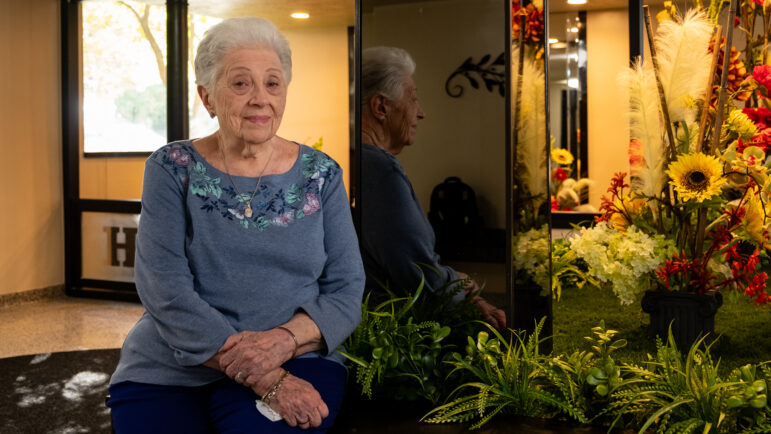
Adi Talwar
Arlene Fleishman, a resident of Linden Towers Co-op in Flushing, Queens. Fleishman has been president of the co-op board for more than 30 years.On the evening of Oct. 12, representatives from some of Queens’ largest housing cooperatives gathered at the Linden Towers Co-op in Flushing for an urgent meeting. Starting in January, each of their properties would be subject to Local Law 97, a historic city mandate limiting carbon emissions from large buildings.
Sitting at a table in her co-op’s main office, Linden Towers Co-op President Arlene Fleishman gazed solemnly around the room, catching the eye of everyone present.
“This is going to be a back breaker,” she said, warning that the renovations needed to comply with the law’s emissions targets would devastate the co-op financially. “We just can’t afford it.”
Local Law 97 is one of the most ambitious—and divisive—climate measures enacted in any U.S. city. Passed by the City Council in 2019, the law calls for most buildings larger than 25,000 square feet to meet new fossil fuel emissions standards next year, with limits getting tougher in 2030 and again in 2050. Failure to comply could result in fines of $268 for every emissions ton above the limit.
Environmental groups say the requirements are crucial to achieving the city’s climate goals, pointing to the impact of increasingly severe weather on residents and infrastructure. Pollution from buildings accounts for around 70 percent of New York City’s greenhouse gas emissions.
But the law has proven especially contentious among co-ops, which make up a sizable portion of the city’s housing stock and are overwhelmingly covered by the statute. While some co-op boards see the mandate as an opportunity to make sustainable upgrades to their buildings, others say it will drain their financial reserves and worry it could drive residents out of their homes.
During the meeting in Flushing, Fleishman argued that Local Law 97 poses an existential threat to middle-class living in New York. “Co-ops in communities like ours are … the only affordable housing left in the city,” she said. “But this is going to kill us.”
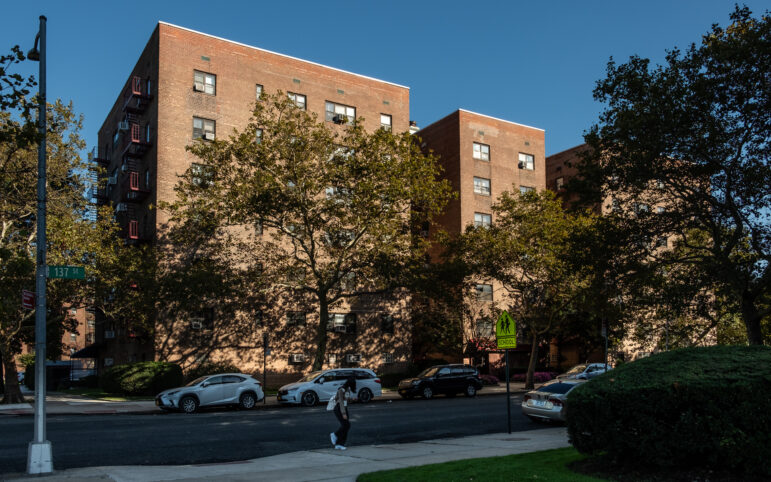
Adi Talwar
Linden Towers Co-op in Flushing, Queens.A financial bind
Close to 90 percent of the buildings covered by Local Law 97 already comply with its 2024 emissions requirements, the Department of Buildings (DOB) announced in August. But a much smaller share (37 percent) meet the stricter standards for 2030—a 40 percent drop in emissions compared with 2005 levels.
Buildings facing the toughest path to compliance include older co-ops, which tend to rely on oil or gas for their energy needs. Energy bills and other expenses—including property taxes and building repairs—are collectively covered by residents through monthly maintenance fees.
Over the past year, co-op representatives have voiced concerns that installing cleaner energy systems would raise maintenance fees through the roof.
“Where’s the money going to come from?” said Brian Lewis, a board member at Mitchell Gardens Co-op II in Flushing. “We have a lot of elderly people on fixed incomes, and a lot of people that are raising families and making it from paycheck to paycheck.”
In response to concerns over cost, the city has unveiled a series of resources and regulations aimed at boosting compliance with Local Law 97 and helping property owners avoid penalties. The NYC Accelerator program offers access to free, personalized guidance from licensed energy consultants, and building owners can take advantage of various tax credits and subsidies to fund decarbonization projects.
“We’ve never had more money on the table from an incentive standpoint on decarbonization than we do right now,” said John Mandyck, CEO of Urban Green Council, a local nonprofit supporting energy efficiency upgrades in buildings. “I don’t discount the fact that it is costly, but these incentives are meant to help offset those costs.”
In September, the city proposed new rules for implementing Local Law 97 that included a two-year extension option for buildings that don’t meet the 2024 emissions targets. Under this so-called “good faith effort” extension, property owners could avoid fines for two years if they submit decarbonization plans and prove they are working toward greater efficiency. Owners that apply for the extension but fail to follow through would be fined retroactively.
DOB accepted feedback on the rules through late October and is expected to issue final regulations before the end of the year. The “good faith effort” provision has drawn praise from some experts, who called it a pragmatic way to increase compliance with the law.
“It’s not a Get Out of Jail Free card,” Mandyck said. “You still have to have your equipment ordered and your financing in place. And you have to commit to meeting the 2030 emissions [limits].”
Environmental groups and some lawmakers, however, have slammed the rules as a giveaway to the real estate sector. They’ve criticized both the two-year extension on the 2024 pollution caps and another provision that allows building owners to offset their emissions totals by purchasing Renewable Energy Credits, which critics say amounts to buying their way of compliance (though owners who apply for the “good faith” extension would not be allowed to purchase those credits).
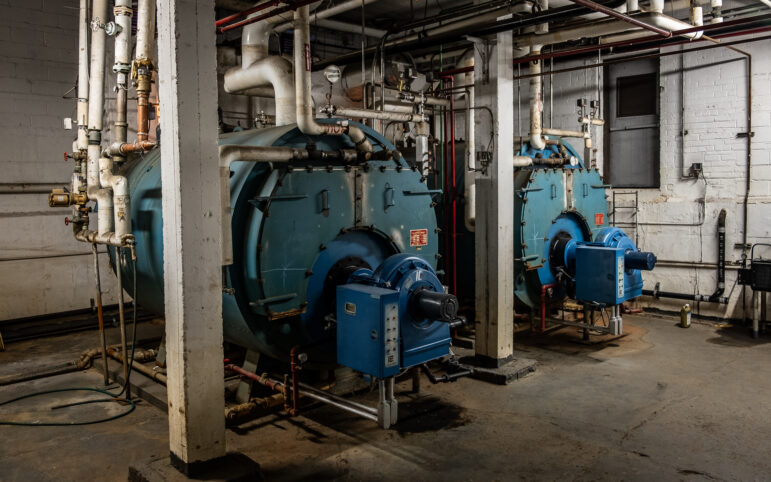
Adi Talwar
The boilers at Linden Towers use natural gas to heat water.Organizations representing the city’s co-ops say the regulations still fail to ease the financial burden of Local Law 97, especially on residential buildings in the outer boroughs. They note that even with the two-year extension, co-ops would have to take immediate steps to meet the 2030 emissions targets, a process that would likely require replacing fossil fuel systems with electricity.
“That’s not a realistic expectation for most of these buildings, because it’s cost prohibitive,” said Geoffrey Mazel, an attorney and board member at Homeowners for a Stronger New York, which represents co-op boards. “You’re asking co-ops to commit to a project that could bankrupt them.”
Linden Towers in Queens is better positioned to comply with Local Law 97 than other neighboring co-ops. Its boilers run on natural gas—which produces fewer pollutants than oil or coal—and its three buildings have insulated windows and energy-saving LED lights.
Still, the co-op’s carbon emissions are well above the law’s 2030 limits, and options for phasing out fossil fuels—including replacing its boilers with electric heat pumps—could be priced in the seven figures.
The cost of any large-scale electrification project would ultimately be reflected in residents’ monthly maintenance charges, Fleishman explained. She warned this would have disastrous consequences for the seniors and young families that call Linden Towers home.
“They’re asking us to come up with the same funds as the wealthiest buildings in Manhattan,” Fleishman said. “No matter how you look at it, it’s our shareholders who are going to suffer.”
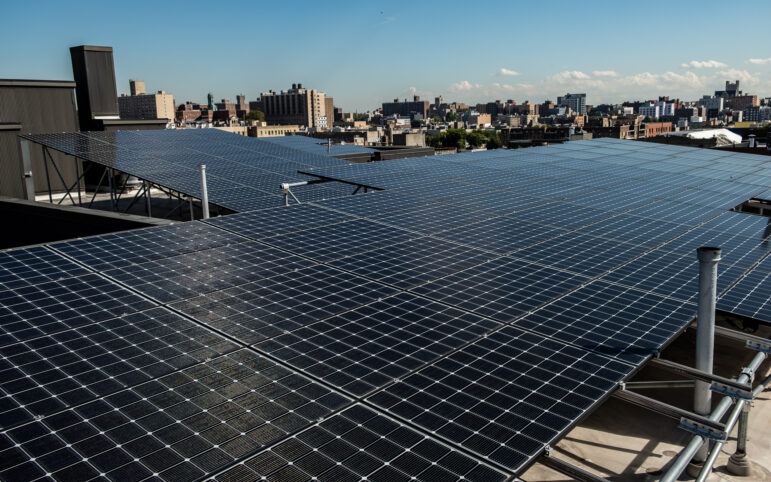
Adi Talwar
Solar power panels at the Sherman Terrace co-op in the South Bronx. The panels were installed in 2020.A moral imperative
Not every co-op outside of Manhattan views Local Law 97 as a threat. Shortly after the statute was passed, the board of Sherman Terrace Co-op in the Bronx approved the purchase of a boiler burner capable of running on gas. The following summer, it installed five massive solar panels on the building’s roof, further reducing carbon emissions and lowering residents’ utility costs.
“We gained $37,000 from using solar [in 2022],” said board member Derek Jones, explaining that the figure is deducted from the co-op’s year-end electricity bill. The board paid for the panels by refinancing the co-op’s mortgage and applying for public grants earmarked for solar projects.
Supporters of Local Law 97 cite properties like Sherman Terrace as evidence of the law’s effectiveness. They point out that the number of buildings out of compliance with the 2024 emissions standards has shrunk by almost half since 2019.
“The pending deadlines are incentivizing buildings to take major action to decarbonize,” said New York City Council Member Lincoln Restler, who sits on the Council’s committee for environmental protection. “Our goal is not to impose significant additional expenses, but rather to help buildings make smart upfront investments that can save money over time.”
Other elected officials are more concerned about the law’s financial toll on residential buildings. In September, City Council Members Linda Lee and Sandra Ung introduced legislation that would exempt co-ops from paying emissions-related fines until 2036. The measure, Intro. 1197, would also empower local courts to adjust penalty amounts based on a property’s median unit value. It currently has 21* co-sponsors.
“The statute is targeted to the most vulnerable buildings,” said Mazel, whose organization played a key role in drumming up support for the bill. “It gives them a little breathing room, but again, they still have to comply” with the law.
Environmental groups say bills like Intro. 1197 would blunt the impact of Local Law 97, allowing building owners to delay renovations and sacrificing urgently needed carbon savings. They add that pushing back compliance deadlines would imperil thousands of new jobs associated with retrofit projects.
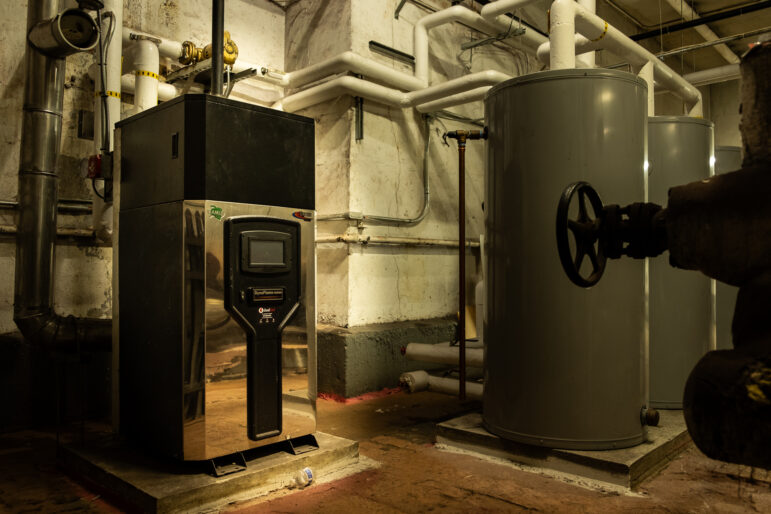
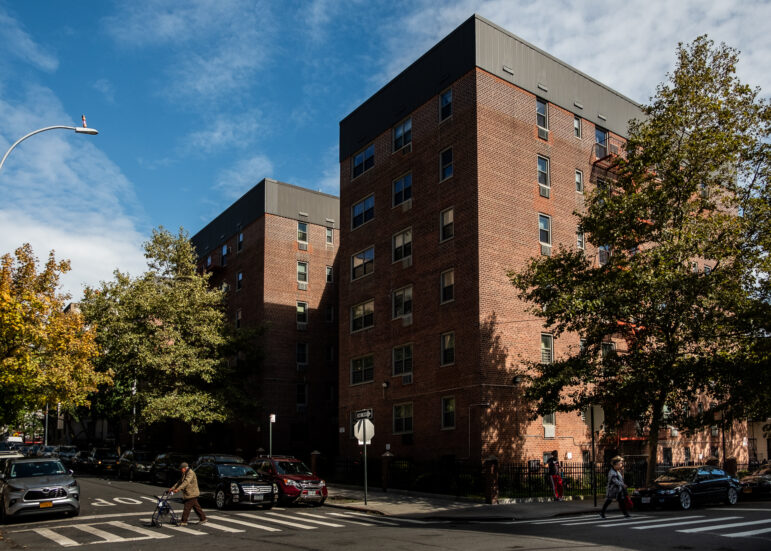
To save energy during the summer, Sherman Terrace uses a smaller heater to supply hot water to the co-op’s 68 units. (Adi Talwar)
“We don’t have time to be fighting defensive battles on climate action,” said Pete Sikora, the climate and inequality campaigns director at the nonprofit New York Communities for Change. “We’ve got a desperate situation here where pollution needs to be radically cut right now, in order to avoid global catastrophe.”
Extreme weather fueled by carbon emissions has had a profound effect in New York City, where severe flooding shut down subway lines in September and excessive heat causes hundreds of deaths each summer. Transitioning away from fossil fuels is the only way to slow the pace of climate change and prevent greater carnage down the road, scientists say.
Jones believes it’s possible for co-ops to ditch fossil fuels and comply with Local Law 97 while still remaining solvent. He urges other boards to share resources and help nearby co-ops become less carbon-dependent, arguing that residential buildings must do their part to rein in the city’s emissions.
“For me, this is urgent,” he said. “I understand the costs, but there’s no time to putz around. We’ve done this to ourselves. So we’ve got to fix it ourselves.”
*This story has been updated to correct the number lawmakers sponsoring Intro. 1197. It has 21 co-sponsors, not 12.
To reach the editor behind this story, contact Jeanmarie@citylimits.flywheelstaging.com









4 thoughts on “‘This is Going to be a Back Breaker’: Landmark Climate Law Poses Test for NYC’s Co-ops”
Excellent article on the environmental requirement for co-ops. The degradation of the environment requires an immediate response, and the article points out various ways to solve the monetary issue for the boards of co-ops.
The city’s public housing are not required to comply with Local Law 97, yet constituent a sizeable stock of carbon emitting residences. If NYCHA undertakes the same emission reductions as coops, this would increase the market for electric heating retrofits thus prompting suppliers to increase production and scale. It’s unfair to exempt the city (as landlord) from compliance with a policy that’s considered urgent for everyone’s benefit.
Given that other places are still burning coal, I question how efforts in NYC will have any effects on climate change. If changes must be made, it is best to start with new construction. Excepting buildings with single-pipe steam heating to change their heating systems is unreasonable.
I live in one of the six Linden Towers sections and the wiring was designed in the 1950s to conform with ConEd’s master metering scheme. There is a circuit for each vertical line of apartments. There is no way of turning off individual apartments. The two outlets for the living room and master bedroom ACs are not on the apartment circuit breaker box. Submetering would be very difficult.
Solar panels are also problematic in these non-fireproof buildings. By the time you eliminate the required 6-foot margin about the roof and allow for walkways from the two stairways to the three rear fire escapes, there is very little space for them.
I know that there are electric steam boilers, but how costly they are to operate in the local environment is a question. Whether ConEd could even reliably provide the new power required by changes is a question.
It is possible the law might be overturned by 2030, but whether or not I whether or not I have to worry about it at my age is a question.
Thanks for sharing this information it is very helpful for me